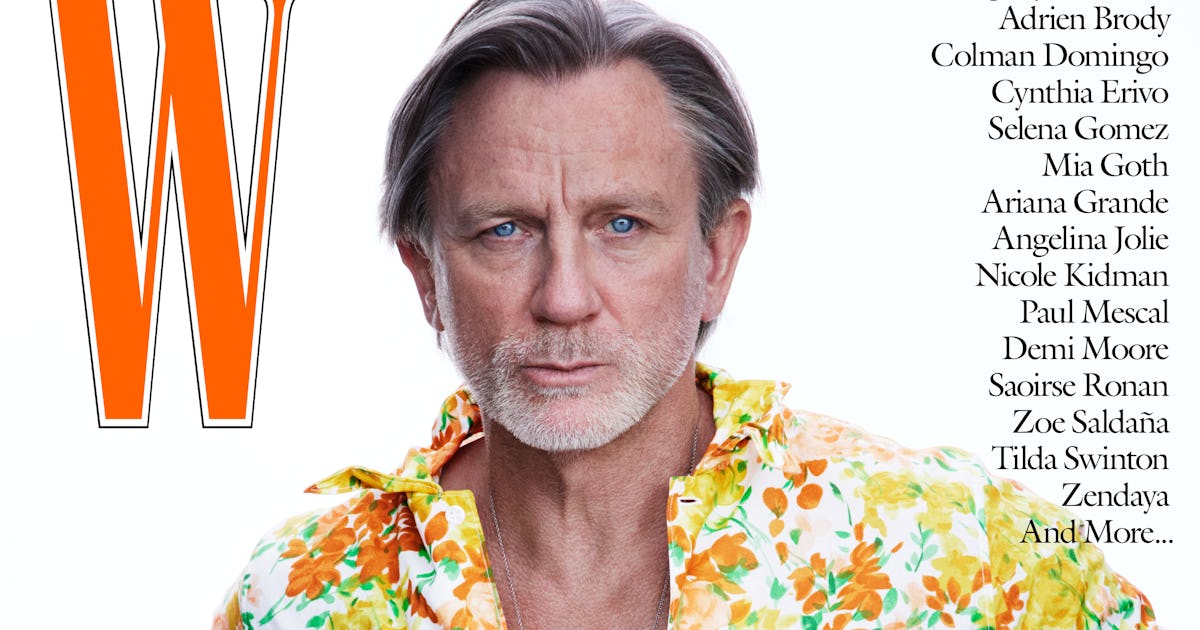Although he may be best known for playing spies, detectives, soldiers, and outlaws, Daniel Craig didn’t purposely set out to go against type in Queer. He just wanted to work with director Luca Guadagnino, and the role of a cross-addicted American writer who gets intimately involved with a younger, discharged male Navy sailor (played by Drew Starkey) while fleeing a drug bust was the part Guadagnino sent over. “I didn’t think twice about it,” Craig tells W’s editor at large, Lynn Hirschberg, of his decision to sign on to the project, sex scenes and all. The Golden Globes, it turns out, didn’t have to think twice about nominating Craig for best actor either. For the 1950s-set movie, which is based on William S. Burroughs’s 1985 novella of the same name, the cast and crew worked hard to get the details perfect, right down to the underwear—which is something the 56-year-old British star credits to the exacting eye of Loewe creative director Jonathan Anderson, who served as costume designer.
Before accepting the part in Queer, had you read the book?
I hadn’t. But I had read Junky, by Burroughs, and I knew of him. The film came together very quickly. Luca Guadagnino contacted me and said, “I’ve got this project,” and I was dying to work with him, so I didn’t really care what it was. Six months later, we were shooting at Cinecittà, in Rome.
Even though the film is set in Mexico City.
The Mexico City in the book—and in the movie—doesn’t exist anymore. Luca wanted to make something that felt classically Hollywood, but also a sort of fever dream. Burroughs took a lot of drugs.
The costuming in the film is so important to conveying the time period.
The brilliant J.W. Anderson, who did the costumes, made a decision with Luca very early on that we weren’t going to try and re-create the suits, because however well you made them, they wouldn’t look like they were lived in. So we used original Brooks Brothers suits from the period, which had real history in them.
And then there’s the underwear.
Let’s talk about the underwear. I mean, what were we going to do? A kind of thong? That would be a bit of an anachronism, wouldn’t it?
There were buttons.
Jonathan wasn’t sure I was going to wear the underwear. It was my idea to get garters for the socks. And, actually, there are some really beautiful photographs of Burroughs and his lover lying in bed in that underwear, wearing suspenders on his socks. So I kind of wanted to re-create that image.
Craig wears a Loewe suit and sneakers; Omega watch; Falke socks; his own necklace; Jacques Marie Mage sunglasses.
It’s interesting that ayahuasca is in the movie. It feels so trendy right now.
I haven’t taken it. I’m too terrified of it, but lots and lots of people I know have taken it. Within movies, drug trips can be really boring. So Luca, his vision for it was just beyond.
What was the first job you booked?
A movie in Zimbabwe called The Power of One, in 1992. I played a two-dimensional South African policeman with a huge chip on his shoulder. It wasn’t a huge push.
Do you like the auditioning process?
I’m terrible at auditioning. Sam Mendes just laughs when he thinks about the audition I did for Road to Perdition. He went, “Stop! You’ve got the job!” I was so bad, he had to give me the part. But now I love the process. It’s a way of seeing if you can be in the same room as each other for a prolonged period of time, whether they’re assholes or you’re an asshole—whichever.
Have you ever lied about something you can or can’t do to get a part?
Fucking hell! Just about everything! I still do—I always say, “Yeah, I can do that.” Fake it until you make it.
What’s your pet peeve?
Social media—what it’s doing to our kids. It’s smoking, as far as I’m concerned. It’s killing them.
Do you ever get starstruck?
Anybody who’s slightly famous, I get starstruck and lose the ability to speak, or go verbless. Meeting Steven Spielberg for the first time was quite something. I told him a really, really, really dirty joke. He had already cast me in Munich, so it was fine.
Hair by Daniel Erdman; skin by Barbara Guillaume for Circa 1970 at Forward Artists.
Style Director: Allia Alliata di Montereale. Hair for portfolio by Paul Hanlon at Dawes & Co.; makeup for portfolio by Sam Visser at Art Partner; manicures for portfolio by Michelle Saunders James. Set design by Gerard Santos at Lalaland.
Creative producer to Mert Alas & Marcus Piggott: Leonard Cuinet-Petit at January Productions; producer to Mert Alas & Marcus Piggott: Kevin Isabelle; produced by AP Studio, Inc.; executive producer: Alexis Piqueras; producer: Anneliese Kristedja; associate producer: Kimmy D’Ancona; production manager: Hayley Stephon; production coordinators: Miranda Dos Santos, Susan Lucas; photography assistants: John Neate, Jed Barnes, Chris Whitaker, Kendall Peck; digital technician: Niccolo Pacilli; digital assistant: Cassian Gray; postproduction by Dreamer Post Production; fashion assistants: Tyler VanVranken, Molly Cody, Celeste Roh, Raea Palmieri, Tatiana Isshac, Haleigh Nickerson, Lauren Marron, Savannah Steilner, Sage McKee, Frankie Benkovic, Kaley Azambuja, Tatum Sanchez; production assistants: Gigi Rosenfield, Lily Cordingley, Eli Cash, Lex Vaughn, Anderson Renno, Kat Saravia, Kyle Dekker, Wyatt Noble, Brandon Martin, Moose Krupski, Josh Muwwakkil, Bradley Gonsalves, Drew Carter, Thomas Lynch, Alex Kofman, Jackson Schrader, Anatalia Zavaleta, Joseph Wride, Matt Flynn; first AD: Steve Kemp; location manager: Kyle Hollinger; hair assistants: Kim Garduno, Ben Gregory, Marco Iafrate, Hyacinthia Faustino, Chris Foster; makeup assistants: Shimu Takanori, Laura Dudley, Brian Dean, Beatrice Sandoval; manicure assistant: Cheyenne Vander Schuur; set design assistants: Seth Powsner, Denver Stoddard, Ryan Johnson; tailors: Irina Tshartaryan, Ripsime Vartanyan, Jackie Martirosyan at Susie’s Custom Designs, Inc.

